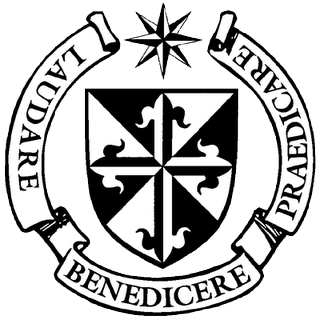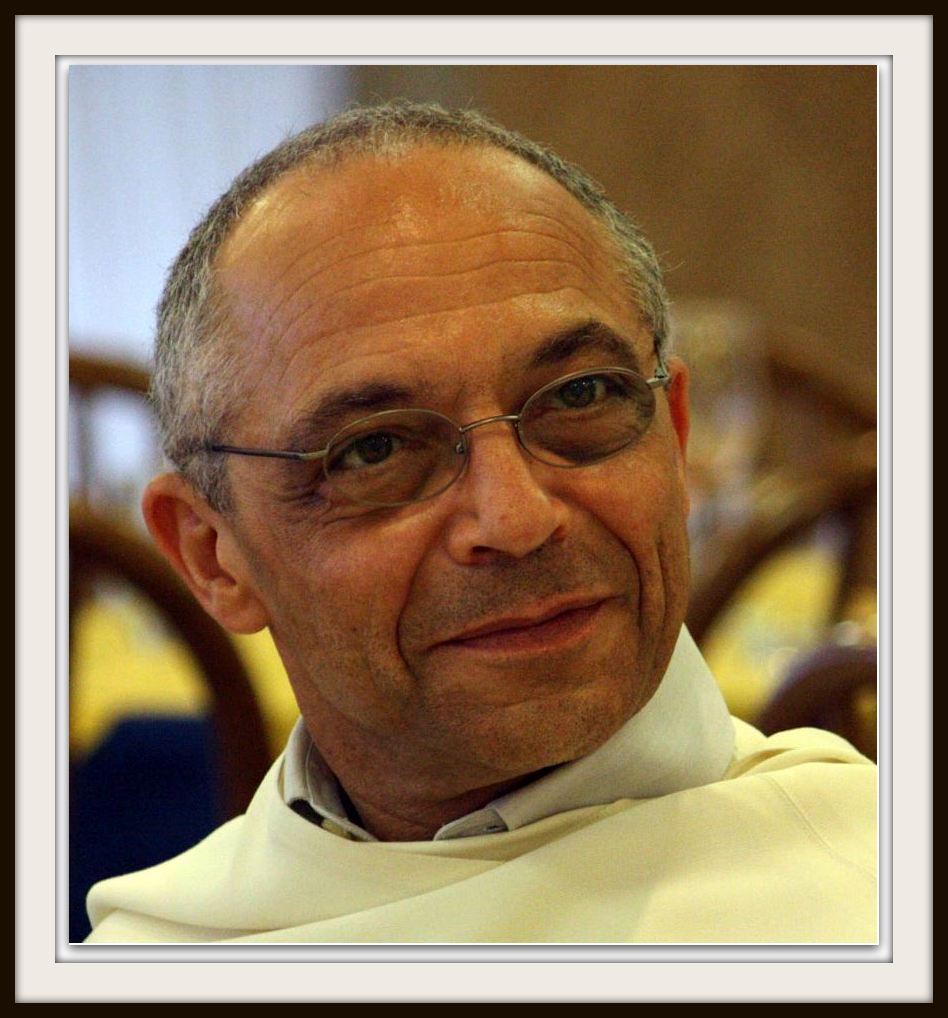
  The three challenges facing evangelization today were raised by the Master of the Order, Fr Bruno Cadoré OP, in his speech, delivered on Monday, the 15th of October, at the XIII Ordinary General Assembly of the Synod of Bishops, on the theme, “The New Evangelization for the Transmission of the Christian faith,”
 According to him, the challenge of evangelization finds its joy and strength in contemplation. This insight made by mendicant Orders brings to light three of the challenges that evangelization faces. The challenge of knowledge; faced in dialogue with all seekers of truth, philosophers, scientists, researchers. Deploying the sciences and knowledge provides the opportunity to realize this “beautiful friendship between faith and the sciences†proclaimed by the Council. In faith one contemplates the mystery of the ongoing creation of God and his faithful call to the freedom and reason of man. In friendship we can, with men of science, discern the challenges in order to build together a world for man.
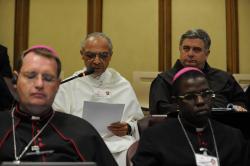 The challenge of freedom. In meeting with our contemporaries, believers and non-believers, it is necessary first of all to present the friendship of God with man, rather than formulating questions and answers that at times are not asked in the proper terms. Being led by God’s patience rather than relying on man, so that he learns to place his freedom at the height of his dignity and to contemplate the mercy of Christ, who precedes him, He who teaches his friends what he received from the Father.
The challenge of freedom. In meeting with our contemporaries, believers and non-believers, it is necessary first of all to present the friendship of God with man, rather than formulating questions and answers that at times are not asked in the proper terms. Being led by God’s patience rather than relying on man, so that he learns to place his freedom at the height of his dignity and to contemplate the mercy of Christ, who precedes him, He who teaches his friends what he received from the Father.
The challenge of brotherhood. Religious communities desire to be places in which brotherhood constructed in diversity aspires to be transformed by the spirit of communion in “sacrament†of friendship of God with the world. And, because of this hope, they are challenged to broaden this hope of communion, tying their destination to the forgotten of the world, making of them the conviction of the Synod of 1971: “Action on behalf of justice and participation in the transformation of the world fully appear to us as a constitutive dimension of the preaching of the Gospelâ€.
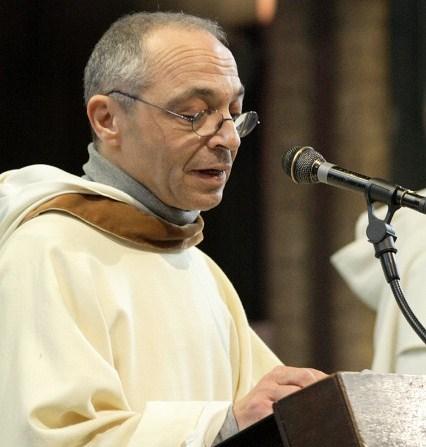
My very dear brothers and sisters,
Â
“Where are you going, Sir Henry?” “I am going to the house of Bethany, he replied.” As Blessed Jordan of Saxony recounts: When Brother Henry left his lodgings and one of his companions asked him where he was going he answered, “To Bethany.” He did not understand Henry’s reply after posing this question to him. Only later on did he understand, when he saw Henry enter Bethany, which means “the house of obedience.” It was Ash Wednesday and Brothers Henry, Leo and Jordan were entering the Order, the “house of obedience.” At that moment and in that place, while the brethren were chanting, they presented themselves before them, much to their surprise, and putting off the old man, they put on the new, thus fitting their actions to what the friars were singing. (Libellus 75) In this way, our brothers situated their vocation as Friars Preachers within the Paschal mystery and the journey towards Easter and rooted it in the common celebration of the liturgy. I am writing this letter to you about our common celebration of the Liturgy of the Hours (ACG Rome 2010 n° 79). In so doing, I am mindful of this moment in the life of our first brothers and of our own experience as we begin that part of “Ordinary Time” which follows the great Feasts of Easter and Pentecost. I shall neither dwell upon the necessity of our celebrating the Liturgy of the Hours together, nor upon our promise to do so. Each of us knows the Constitutions of the Order and the Letters of Promulgation for the different
liturgical books of the Proprium OP. What is more, each of us is aware of what it means when there is a lack of commitment to our common prayer. It is by building our regular life, personally and communally, upon this common celebration that we choose patiently to build the unity of our communities rather than to submit to the arbitrary subjectivism of the individual. Also, I have no wish to dictate the form of this celebration. Travelling around the Order the last year and a half, I can see how our customs differ. And yet, I can also see how much the unity of a community and a province can be fostered when care is given to our liturgical prayer. There is no doubt that we need well-prepared celebrations. We all know the delight of a beautiful liturgy, even when it is simple. At the same time, we all are painfully aware of the exhaustion, disappointment and tension that arise when our prayer is celebrated with excessive formalism or extreme casualness. At such times, the heart and reason for our celebration risks being displaced, causing us to turn our focus away from Christ and toward ourselves. Instead, I would like to make two simple, yet radical points. The first is that our common celebration of the Hours is like a series of landmarks that direct our lives as we seek to give them over to our mission of preaching. Our prayer orients us on our journey of conversion, from Ash Wednesday to the Light of the Resurrection where we pass from the “old man to a man born anew” through the grace of that Breath of Life given by the Risen Lord. The second point recalls the expression used by Blessed Jordan: our common celebration of the liturgy allows us to encounter the source of our obedience and to draw from it. This obedience is to the mystery of the Word who comes to “configure himself’ to humanity, so that humanity might become configured to God. Our common celebration unites us in obedience to the Word to whom we have prayed for the grace of consecration (“Consecrate them in the Truth. Your Word is truth”). The liturgical celebration thus clearly leads us to the source of our obedience to the One who calls us to preach the Word of God and to participate in the work of evangelization. As a “house of obedience”, our liturgical celebration invites us again and again to approach this call to unity, which I wish to consider from three points of view.
Celebration of unity in the Word
No doubt when each of us was moved by the deep conviction that we wanted to give our life over to preaching in the Order, we were also delighted by the joy of being able to pray with brothers and sisters. Together in listening to the Word of God, we become aware that this Word gradually comes to live in our own words. We bless and praise Him who unceasingly enters into the heart of humanity. Most often we pray in the choir which is arranged around a central empty and open space, open specifically to receive the One who comes. We do not go to the choir primarily to fulfill an obligation which we have assumed; but rather we assemble in choir to await together Him who comes, to welcome Him and, above all, to learn to recognize Him. The liturgical celebration of the Hours, repeated several times a day in community, must be a time when the Word of God, and not ourselves, comes to be our center. It is when we allow the Word to seize us, to take hold of our desire to give our life and enable this desire to do far more that we could ever do ourselves. This celebration repeated each day and in each liturgical Hour gives us the courage to expose ourselves to the Word; to listen to the words of Scripture and the prayers of the tradition; to become accustomed to the familiarity that the Word wants to have with us; to discern through the words of Scripture the face of the Son that is revealed and who is the very source of obedience. We need constantly to regain our strength, to take heart. It is in this mystery of the liturgy that we learn how to do this, or better, in the liturgy we can implore the Lord to do it in us. What is the work of grace that operates in us, both individually and communally, through the liturgy? I would venture to say first of all, that each celebration of the Office leads us once more to anchor our lives in those gestures of our profession. “What do you seek?” “God’s mercy and yours.” Who among us has not been touched to the core at the beginning of Compline, when placing ourselves in the presence of God, we echo that question and response by which we announced our desire to make profession? In the presence of our brothers, each of us is helped once again to receive assurance of that mercy and forgiveness which gives us the courage to raise our eyes. Each of the other Hours begins with the cry for assistance to Him who alone can support our life, our fraternity and our preaching. We all know those days of which we are least proud; the days when we would have liked to have been more just, more caring, more attentive, less complacent; those days in which we no longer expected anything from the Lord; those days when our enthusiasm to begin anew, the radicalism of response and the generosity of the gift of self were not brought to this daily encounter with Him. The Daily Office, the “sanctification of the hours”, is an act of faith for us that, despite our failings, brings us always into the Presence of God. It is this promise that we celebrate, doxology after doxology, bow after bow. “Rise, brothers”, is the response to us on the day of profession. “Rise”, heard Blessed Jordan, “and put off the old man in order to be clothed in that new man.” The intuition of these young men going to the house at Bethany shows us the way that opened on the day of our profession, a way that leads to Easter. The liturgical celebration of the Hours writes this mystery of Easter on our heart even in the most ordinary part of our day. It envelops our own personal histories into a time that goes beyond us, and yet brings us into our true selves. It is the time of the promised covenant, heard in Scripture and sung in the Psalms, which gives us the words to tame and to be tamed by this Presence in every issue that confronts us and so enables us to respond to this call. It is the time of Christ present and recognized by those who were the first witnesses of his Presence and his mystery. It is the time of humanity who, recognizing the Risen One, dares with the brothers of Emmaus to implore Him to stay with them. If we celebrate the liturgy of the Hours day after day and throughout the course of each day, it is so that our time is really, strongly, seized by this
Presence and becomes a place to recall this mystery. To be clothed in the new man, it is best to let the mystery of Christ take the place of the clothes of the old man. We know that the tradition of the Order stresses (and the Constitutions ask) that, at the heart of this celebration of the Hours, the brothers celebrate the Eucharist and that they do so together in the Conventual Mass. We must consider once more the strength of this demand, which many of us would emphasize in our retreat talks for religious communities. Fraternal communion is rooted and finds its vigour and joy in the communal Eucharistic celebration. On account of their ministry it may well be that brothers must offer Mass in their parishes or for particular groups. Nevertheless the communal Eucharistic celebration must not remain for us merely an occasion for each priest to celebrate Mass when he has not already said his Mass somewhere else. Rather, it should be a pressing invitation to each brother, priest or not, to receive the Lord’s life in the Eucharistic sharing among his brothers. “Stay with us Lord … ” we say together like those disciples on the road to Emmaus, and make our hearts bum, impatient to follow you in our apostolic journey! Our communal celebration of the Eucharist should make us impatient to live truly together, rooting our preaching in the unity of our community of brothers. This we receive day after day in the broken Bread and the shared Cup.
Celebration of unity in fraternity
The liturgical celebration of the Hours must be a fraternal event. With the passing years and centuries, perhaps the liturgical celebration has gradually taken on the appearance of an observance, an aspect of the regular life in which we are engaged, a formal rite that we must fulfill like ticking off an item on our daily check-list. But, if when celebrating the Hours we celebrate the approach to Easter, then we are far from formalism or an obligation to fulfill a rite, to ‘say our office’. (Think of when we place the body of a brother who has died among us in the choir until his funeral. We do this less to indicate that the brother is still with us, than to return this brother, precisely because he is no longer with us, to Him who comes into our midst in order that He might bring this brother into His Easter.) It is Easter that urges us to hurry to the Office. It is the mystery of life always newly given that must make us impatient for this encounter. It is the joy of fraternity, sealed by the Eucharistic sharing, that unites us to celebrate together the hope of the coming of the Word of salvation. Fundamentally, we celebrate the coming of the Word as that unseen source and foundation of our fraternity. Does not our coming together in choir several times a day give us the opportunity to recall the unfathomable mystery of grace? He comes to speak to the world and to us, giving us the strength and the words to dare to speak in our tum to Him. We let go of our own discourse and wisdom and everything we think we know in order to let Him speak. Several times a day we should ponder the joyful mystery of the Finding of Jesus in the Temple: He alone is the teacher who opens the meaning of Scripture! Liturgical celebration is a constant thread running through our days so that we might be woven in our ‘consecration to the truth, which is the Word’. It is a consecration that we recall together, by which we are sustained together, and through which we are offered together. The liturgy of the Hours, tradition says, sanctifies our chronological time to God; in its repetition and duration, the
liturgy consecrates our own interior “duration” to the truth that is the Word who comes. It is in this perspective that our Constitutions invite us to base our communities around the common celebration of the Eucharistic mystery (LCO 3). We might have been particularly generous at the first or the sixth hour; we could have confronted apostolic or personal discouragement at the third or the ninth hour. But there is one hour, always favourable, when it is the right time to draw strength and joy from the source of life. There is the favourable hour to give in our turn the life that we have received with a firm heartfelt desire for the salvation of the world. Once again, of course, one can raise objections, such as the number of masses to be celebrated in certain apostolic and pastoral places, or the question of the rite one would like to celebrate. The Order is based upon the communal celebration of the mystery at the heart of all mystery and must lead us to renounce, absolutely, all temptation to relativism, which would favour our own work, choices or preferences over and above the One who is the source of our unity and the foundation of our community. There is a single unity between the celebration of the Liturgy that sanctifies the Hours and the Eucharistic celebration that brings communion. In the same way, when we live the apostolic life, there is a unity between our preaching about the issues we encounter in the world and the service of charity we give to the world. There is a single, profound unity that enables us to live within the liturgical celebration of the Hours our apostolic work and patient study. For it is always a question of our being ready to recognize and welcome the Word that comes. By seeking to live together in this unity, we celebrate the presence among us of Him in whose name we offer as the hope of salvation.
Celebration of a unity received for the salvation of the world
Into the heart of the community gathered for and through the celebration, it is not only Christ who comes, but also the world. The celebration is in fact the moment when love for the world is nourished in fraternity. We say of Dominic that he spoke either of God or to God; speaking of people to God or of God to people. We say of him, that he never ceased to intercede for the world. The liturgical celebration of the Hours is the place par excellence where our communities bring into the presence of God our aspirations for the world to which we are sent as Preachers. We already bring these aspirations to Him by proclaiming the words of the Psalms that express man’s desires with so much insistence, his longings for salvation, and his frequent incomprehension at what makes up his story. We bring these aspirations for the world when, by singing the Psalms, we make the story of the people chosen by God our own story. It is in being in the world in this way that we are a sign of the promise that the world can become a ‘world for God’. Dare we say that, by singing the story of a people for God in the midst of the world, we can open a breach in our contemporary history? A breach that allows us to raise our eyes beyond what seems to be the limits of our destiny and beyond what appears as a ‘dead end’ or an absurd barrier from a worldly perspective? We sing of the promise of a Presence and a Coming that does not accept ‘dead ends’ from a human point of view, but on the contrary, projects the Light of a promise of eternity onto ordinary situations. To sing the liturgy hour after hour calls us to be convinced that the world is saved and heard even in the midst of its own noise. For Preachers, therefore, the world is placed hour after hour under that sign which enlivens our consecration to the Word, namely, our desire for its salvation. Of course, we again bring these aspirations for the world into the prayers of intercession, which are so important in our tradition. Since Dominic first cried “what will become of sinners” intercession has been a specific aspect of our spiritual tradition. The choice of the apostolic life brings with it as a consequence our acceptance of the sorrows and the joys of the world: its hopes and fears, certainties and doubts. Just as consecration to the Word invites us to let the Word take our lives, transform them and raise them up to the Father, so our shared destiny with the world must dwell in us and constantly invite us to new Understandings of the Promise. It must teach us to raise our eyes to the Father, presenting him with the needs and concerns of the world. ‘I do not pray for them only, but for all those who have believed through them’. This is a double movement: the Word takes hold of us and in tum we speak a human word to God which recalls Christ’s concern for the world. This double movement “conforms” us to Him who has opened the way to apostolic life. It is one and the same thing to speak to the world the Word of God in which we want it to be consecrated and to speak to God the words of the world with its hopes and fears. Sometimes we are fairly timid in our intercessory prayer, or even quite formal. We should dare to engage more fully in intercessory prayer which is an essential aspect of the spiritual school of Dominic, because it was the prayer of the Lord whom Dominic wished to follow as a preacher. Dominic asked his friars to celebrate the Hours publically. During the course of each day our communities are invited to open their prayer to the world. We recall in the presence of God the joys, hopes, pains and fears of the world. Liturgical celebration is thus a compelling part of our mission of evangelization (to spread the Church to the ends of the earth). It is an aspect of our office of preaching. Glorify God and give thanks for the extraordinary love that He gave the world and by which, without ceasing, He sustains Creation. Humbly receive the grace God gives us to intercede with Him for the world and to speak to him of those whom we commend in our prayer. Accept as well that grace by which God touches our lives when we ask Him for the world’s salvation. Dare to believe that day after day through intercessory prayer the Spirit conforms us to the true image of the Son’s praying to the Father, despite the clumsiness and indignity of our words. ‘Father I desire also that those whom you have given me may be with me where I am.’ By our ordinary work being interrupted, by our ‘leaving’ the world to break into prayer, we give thanks for the sanctifying Presence of God who broke into our world. Are we not established as a community of preachers through the Spirit who patiently conforms us to the image of Him who is the only Preacher? Do we not allow Him to bring our awkward prayer to the Father and place in us that desire for salvation for which He gave his life and for which we wish in our tum to be preachers? And so, with Him, let us proceed further each day towards Easter and let us ask for the Spirit, in order to preach.
On the Feast of the Visitation
Fr. Bruno Cadore, op
Master of the Order of Preachers
 Download PDF file from here:  MO Letter to the Order EN
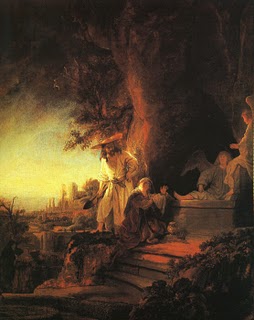
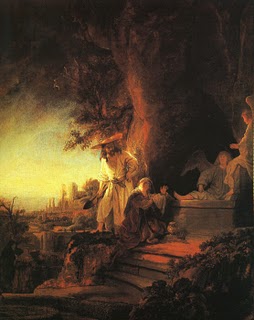
“He is not here… He is risen!†These are the words the angels will use this morning to announce the Resurrection to the women. “He is not here… He is risen!†But what will these few words allow the women to believe? How will this short sentence allow them to pass from sorrow into hope? How will these words of the angels “He is not here… He is risen!†make it possible for them to hope again in life after the immense sorrow they had just passed through?
Indeed, these women’s sorrow was immense and, crushed by this sorrow, they came to the tomb on that early dawn, which would be Easter. They were crushed, indeed, for they had seen the Master, the Lord, Jesus. They had followed him. They had listened to him speak of the goodness of the Father. They had heard him speak to all people, starting from the little ones. They had seen him raise the little ones, and then speak to the learned, to the powerful and tell them that they were wrong to think that, because they thought that they knew God, they could exercise power over the little ones, and tell them what they should know about God and somehow impose on them a way of life. The learned, the powerful had believed that they possessed God. They thus dispossessed the little ones of God. And when the powerful and the learned heard the Son of man, the One who spoke of the Father challenge their words, they arrested him, and then they silenced Him. And then they killed Him!
And the women had seen all this and it is in this sorrow that, on that morning, they came to the tomb in silence, crushed. They wanted to render a last homage to the body of him whom they had followed, the one they loved. And in that silence, suddenly, the angels speak: “He is not here, He is risen. Remember… He told you, He promised you!†All of a sudden the silence is no longer one of absence, an oppressive silence, the sort of silence in which one can say that one is all alone and from which there is no way out. All of a sudden, silence is the lace of the Word. The Word the authorities had wanted to silence resounded anew. This Word is the promise of life above all, of life for all starting from the little ones, starting from those whom people wanted to silence, starting from those that are marginalized. This Word was given to them. From then on, silence was the place where the women listened to the Word of God. Then they looked at the tomb, and the tomb was empty! This empty tomb is a curious sign that speaks of Resurrection. Often, indeed, we do not like emptiness, it frightens us, and it offers no future. Sometimes it makes us believe that nothingness, death, and anguish can take man and enclose him once and for all. We do not like emptiness.
The women looked and the tomb was empty… “He is not here†… From the empty tomb the women understood that it was not an absence that they had to witness, on the contrary, it was the rising of the One who had been crushed by death. It is a new presence that will spring from the empty tomb. The women, then, understood that, contrary to the emptiness that comes from nothingness and death, there was an absence that attracted them to life, a presence that would walk with them for all their life. Silence was inhabited by the Word. Emptiness was filled by the dense presence of The One they loved and that they can love again. But this tomb, like all tombs, was somber, and so, beside the tomb they saw the clothes of the angels, and the Gospel tells us that their vestments were shining with light.
This is Resurrection! We often believe that death, darkness, impasses will have the upper hand on our plans, our projects, and sometimes even on our hope. We often think that everything that darkens the horizon, darkens the world … we will never get out of this! We often think that our destiny is darkness, rather than light. The angels’ clothes are there, and they speak to us, as in the novel by Yasmina Cadra, “What the Day owes the Nightâ€. Night is the crushing of Jesus in death, a crushing from which He rose again. The day is the light of this rising. The angels’ clothes signify that it was necessary for him to pass through death to be crushed and then to live again: He is risen!
When we sometimes think about our resurrection, we imagine that it is for the future, for later on. That resurrection is the future we are promised is true. But today, together with the women by the tomb, we have to believe strongly, otherwise… or better! Resurrection is not something for later on.
Resurrection is first of all that of Christ, and our life begins with the resurrection of Christ.
This is the message of the empty tomb: our life begins with the Resurrection of Christ. The silences that prevent us from telling our story and from believing in ourselves, the silences that enclose us in ourselves, these silences are now inhabited by the life of Christ, arisen from the dead. Emptiness, anguish, the loss of hope which mark our life, because life is difficult … this emptiness, is suddenly filled by a presence, the presence of the living One, He who is our life. The obscurities, those things that sometimes make us stammer and stumble in life … the deaths, the ordeals we face, what makes us think that death is the end of everything, all of this, today on this Easter morning is illumined by the light of Christ. Yes, He is risen, He is no longer here.
He is risen! And where is He? He is in your life, in the life of each one of us; in the midst of our silences and of our words, in the midst of our words and of our obscurities, in the midst of our relations and of our loneliness. He is life!
Saint Paul said, “For me to live is Christâ€. For us, on this Easter morning, life is the life of the Risen Christ.
Happy Easter !!!
Fr. Bruno Cadore, OP
Master of the Order of Preachers
April 23, 2011
From the Gospel of St. Luke proclaimed during Easter, Bruno Cadoré, Master of the Order of Preachers meditates on the words of the angels: “He is not here, He is risenâ€. Beside the empty tomb the women who received this message were able to hope again, and we with them for life begins with the Resurrection of Christ.
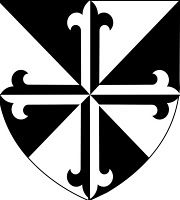
POPE BENEDICT XVI RECEIVED THE MASTER OF THE ORDER
IN PRIVATE AUDIENCE
On March 11, 2011 His Holiness, Pope Benedict XVI, received the Master of the Order and his Vicar in a private audience. The goal of the meeting was to talk to the Pope about the main themes addressed by the last General Chapter and about the status of the preaching of the Order at the on-set of the Master’s mandate. During the meeting, the Pope asked many questions about our placements, formation, our Provinces’ teaching engagements, and the general situation of the Order by individual regions. At the time when a new Pontifical Council has just been appointed, the Pope highly encouraged the Order to keep working on those dimensions of our charisma of friars preachers, which best contribute to the evangelization. He specially highlighted the following dimensions: careful attention to the life-search and the spiritual quest of our contemporaries; the importance of studying and teaching Theology in line of the solid tradition of reflection initiated by Thomas Aquinas; Theology’s essential spiritual dimension; the vital bond between Theology and worship; the particular challenge to Theology posit by the dialogue with new cultures and sciences – a clear sign of our relation with the world; the role of statistics in evangelization; appropriate care given to the human, religious and theological dimensions in initial formation; and the hope that our evangelizing efforts will give our contemporaries the possibility and the joy of a personal relationship with Jesus. (IDI, April 2011 – N° 491)
THE MASTER OF THE ORDER OF PREACHERS VISITS
ST. DOMINIC’S PRIORY
Fr. Bruno Cadoré, OP, Master of the Order of Preachers visits the Dominicans of Our Lady of the Rosary Province in Macau and Hong Kong on January 18-22, 2011. The program of the visit to St. Dominic’s Priory and Studentate in Macau is as follows:
January 18 (Tuesday):
- 18:00Â Â Arrival, Hong Kong International Airport
- 21:00   Arrival in Macau and Greetings to the Community at St. Dominic’s
January 19 (Wednesday):
- 06:30Â Â Meditation and Morning Prayer
- 09:30Â Â Meeting with the Provincial and Formation Councils (Saint Paul School)
- 12:30Â Â Lunch
- 15:00Â Â Meeting with Students
- 18:15  Evening Prayer and Eucharist
- 19:00Â Â Dinner
- 20:30Â Â Socials
January 20 (Thursday):
- 06:30Â Â Meditation, Eucharist with Morning Prayer
- 09: 30Â Â Visits to School of Christian Studies, University of Saint Joseph
- 10:30Â Â Visit to the Bishop of Macau
- 11:30Â Â Short Macau Tour
- 12:30Â Â Lunch
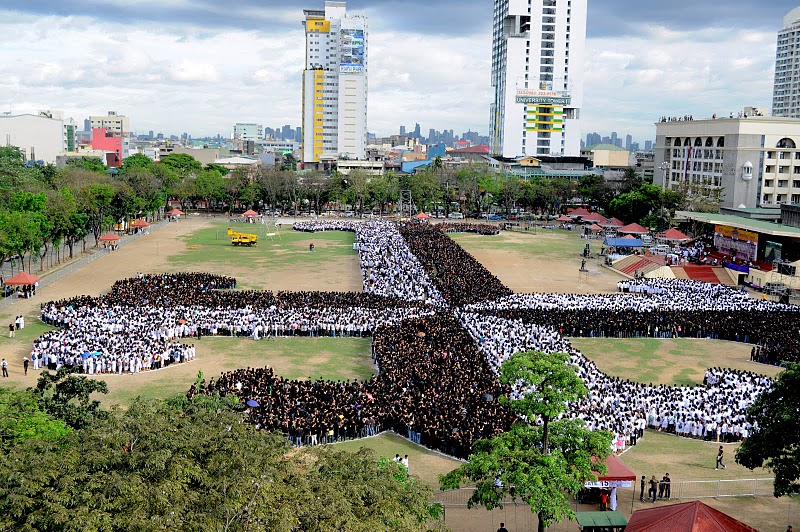

Largest Dominican Cross

Santo Thomas University in Philippines

Largest Human Dominican Cross an attempt for Guinness World Record
We would like to share with you some ground and aerial shots of the “Largest Dominican Cross†formed by the administrators, faculty, employees and students of the University of Santo Tomas (UST) yesterday, March 9, 2011. Twenty-four thousand people were present at the UST football field to form the black and white cross; it was an attempt to be included in the Guinness Book of World Records. This event was done to begin a season of prayer and penance this Lent, in line too with the Quadricentennial celebration of the University.

UNIVERSITY OF SANTO TOMAS CELEBRATES ITS 400TH
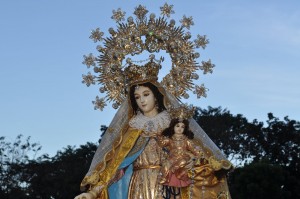 The University of Santo Tomas (UST), Manila, celebrated its 400th Foundation Anniversary with profound gratitude, joyful hope and unending grace. The glorious Grand Week (January 24-28, 2011) of the UST Quadricentennial Celebrations included outstanding religious, academic and cultural events. The Grand Week or Semana Grande of the Royal and Pontifical University began in the evening of January 24 with a solemn Eucharistic celebration and closed in the evening of January 28 with a most solemn Mass and a banquet.
The University of Santo Tomas (UST), Manila, celebrated its 400th Foundation Anniversary with profound gratitude, joyful hope and unending grace. The glorious Grand Week (January 24-28, 2011) of the UST Quadricentennial Celebrations included outstanding religious, academic and cultural events. The Grand Week or Semana Grande of the Royal and Pontifical University began in the evening of January 24 with a solemn Eucharistic celebration and closed in the evening of January 28 with a most solemn Mass and a banquet.
The UST week-long celebration was ushered in by the Opening of the Door of the University Chapel and Santissimo Rosario Parish Church turned through the year-long quadricentennial celebration into a Jubilee Church, where Thomasians, parishioners and visitors may gain plenary indulgences under the usual conditions. Cardinal Gaudencio Rosales, Archbishop of Manila, opened the door of the Church and presided over the Eucharist concelebrated by about seventy priests, most of them Dominicans. In his moving homily, the good Cardinal spoke well of the 400 years of history of the University of Santo Tomas, the oldest university in Asia and now the biggest Catholic University in the world, with forty two thousand students. Archbishop Rosales highlighted some salient points in the history of the university, above all its essential role in shaping the Filipino nation and the Philippine Church. The University counts among its illustrious roster of alumni heroes, leaders and saints, including fifteen martyrs of the faith that constitute UST’s purest glory.
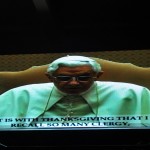 On the second day of the UST Grand Week, the 10th ICUSTA Conference – attended by the members of the association and representatives from Catholic Universities throughout the world – opened with a High Mass, followed by the inaugural session at the UST Chapel, now the Jubilee Church. (ICUSTA stands for International Council of Universities of Saint Thomas Aquinas.) Archbishop Edward Joseph Adams, Apostolic Nuncio to the Philippines, presided over the concelebrated Eucharist. The Keynote Address was given by Ninoy Aquino III, President of the Republic of the Philippines. While the Apostolic Nuncio focused in his homily on the essential role of UST, the Catholic University of the Philippines, in the local Church and other Asian Churches, the President of the Philippines centered his speech on the University’s leadership role in Philippine education through four hundred years. The inaugural session of ICUSTA started with the warm welcoming words of Fr. Rolando V. de la Rosa, OP, UST Rector and closed with the reading of a unique resolution by the Philippine Congress, which praised the University’ s remarkable history and thanked the university community for its outstanding work in molding the youth of the nation. Another highlight of the inaugural session was the Message of the Master of the Dominican Order, Fr. Bruno Cadoré, OP, who thanked the Dominicans in the Philippines and encouraged them to continue their mission in education and evangelization.
On the second day of the UST Grand Week, the 10th ICUSTA Conference – attended by the members of the association and representatives from Catholic Universities throughout the world – opened with a High Mass, followed by the inaugural session at the UST Chapel, now the Jubilee Church. (ICUSTA stands for International Council of Universities of Saint Thomas Aquinas.) Archbishop Edward Joseph Adams, Apostolic Nuncio to the Philippines, presided over the concelebrated Eucharist. The Keynote Address was given by Ninoy Aquino III, President of the Republic of the Philippines. While the Apostolic Nuncio focused in his homily on the essential role of UST, the Catholic University of the Philippines, in the local Church and other Asian Churches, the President of the Philippines centered his speech on the University’s leadership role in Philippine education through four hundred years. The inaugural session of ICUSTA started with the warm welcoming words of Fr. Rolando V. de la Rosa, OP, UST Rector and closed with the reading of a unique resolution by the Philippine Congress, which praised the University’ s remarkable history and thanked the university community for its outstanding work in molding the youth of the nation. Another highlight of the inaugural session was the Message of the Master of the Dominican Order, Fr. Bruno Cadoré, OP, who thanked the Dominicans in the Philippines and encouraged them to continue their mission in education and evangelization.
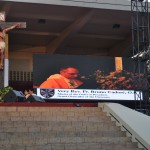
On the third day of the UST Grand Week, January 26, the ICUSTA Conference continued. Moreover, in the morning, thousands of students from the different colleges of the University held a street dance on the streets around the university. It was a scene to see and enjoy – even the noise sounded joyful and youthful!
In the evening of the third day another great event took place: the Unveiling of the Quattromondial Monument found between the back of the UST Main Building and the Benavides Central Library, at the UST Quadricentennial Park. The monument, the latest landmark of the University campus, captures well the motto of the 400th Anniversary, namely, “UST Building the Church, the Nation and the Family, Our Birthright and Destiny.â€Â The monument of bronze-glass and ten-meter-high was made by renowned UST alumnus Ramon Orlina. It is composed of four larger-than-life human figures in bronze representing a male and a female student, a teacher and a Dominican friar. Sculptor Orlina explained that “the four figures represent the four centuries of excellence, erudition, spirituality and tradition that the university has displayed and inspired in every one of its stakeholders.â€Â The four youthful standing figures –with their backs against each other – hold a globe, with their raised-up hands to express the universality of the University, the interconnectedness of peoples and cultures. 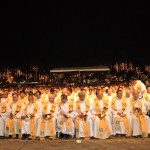 Three significant texts in Latin encircle the figures from top to bottom: the name of the University (Universitas Pontificia and Regalis Santi Thomae Aquinatis), the motto of the Dominicans (Contemplari et contemplata aliis tradere), and the focus of human and Christian education: work ethics and love (fideles in labore, proficientes in caritate).
Three significant texts in Latin encircle the figures from top to bottom: the name of the University (Universitas Pontificia and Regalis Santi Thomae Aquinatis), the motto of the Dominicans (Contemplari et contemplata aliis tradere), and the focus of human and Christian education: work ethics and love (fideles in labore, proficientes in caritate).
The greatest day of the UST Grand Week was the Quidricentennial Day: January 28, the feast of St. Thomas Aquinas, Patron of the University. It was crowned by the Quadricentennial Mass, preceded by colorful Philippine folk dances and powerfully animated by the Symphony Orchestra and Choir of the UST Conservatory of Music. The solemn Thanksgiving Eucharist celebrated at the UST Grandstand and Open Field was presided by Cardinal Zenon Grocholewski, Prefect of the Congregation for Catholic Education and Legate of Pope Benedict XVI. Filipino Cardinals Ricardo Vidal and Gaudencio Rosales, the Apostolic Nuncio to the Philippines, the Master of the Dominican Order, Fr. Quirico Pedregosa, OP, Prior Provincial of the Philippine Dominican Province, about 100 bishops, over one hundred Dominicans, nearly five hundred other religious and secular priests concelebrated with the Papal Legate. The Mass was attended by tens of thousands of Thomasians, parishioners, and friends of the University. In his homily, Cardinal Grocholewski spoke gratefully and admiringly of the great history of the University of Santo Tomas, particularly for the Philippine Church and other Asian Churches. He also referred to St. Thomas Aquinas and underlined three points in the life of the
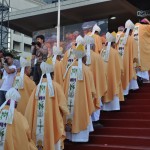
Angelic Doctor, namely, his unique gift to harmonize faith and reason, his admirable humility and his exemplary fidelity to the Church.
The most awaited moment of the Eucharistic celebration was the taped video appearance and Message of Pope Benedict XVI, who was received with a thunderous applause and followed by a respectful silence. After hispaternal greeting to all, the Holy Father acknowledged the great importance of the event and recalled with gratitude the memory of the Founder of the University Bishop Miguel de Benavides and of the Dominicans who through 400 years guided well the University of Santo Tomas. Benedict XVI sees a very important role for the University and is convinced that it will continue contributing to the intellectual, spiritual and cultural enrichment of the Philippines and other countries. Invoking the memory of UST’s Patron, St Thomas Aquinas, the Holy Father ended his message with his Apostolic Blessing to all.
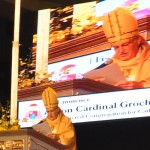
Before the end of the Eucharist, Fr. Rolando de la Rosa, OP, UST Rector expressed the deep gratitude of the University to all those who made this wonderful day possible. He mentioned in particular, the members of the Dominican Province of Our Lady of the Rosary, for  their important contribution through the 400 years of the University’s history.
A banquet in the 24-hectare campus for the whole university community followed the Eucharist. The day was capped by a short but colorful and elegant display of fireworks. As professors, alumni,
students and administrators were leaving the campus, one sentiment stood out: all seemed happy and proud, outrageously happy and unabashedly proud for being Thomasians at 400!
The yearlong celebration of the 400th year foundation anniversary of the University of Santo Tomas continues – and with its unending grace. (FGB)

 The challenge of freedom. In meeting with our contemporaries, believers and non-believers, it is necessary first of all to present the friendship of God with man, rather than formulating questions and answers that at times are not asked in the proper terms. Being led by God’s patience rather than relying on man, so that he learns to place his freedom at the height of his dignity and to contemplate the mercy of Christ, who precedes him, He who teaches his friends what he received from the Father.
The challenge of freedom. In meeting with our contemporaries, believers and non-believers, it is necessary first of all to present the friendship of God with man, rather than formulating questions and answers that at times are not asked in the proper terms. Being led by God’s patience rather than relying on man, so that he learns to place his freedom at the height of his dignity and to contemplate the mercy of Christ, who precedes him, He who teaches his friends what he received from the Father.